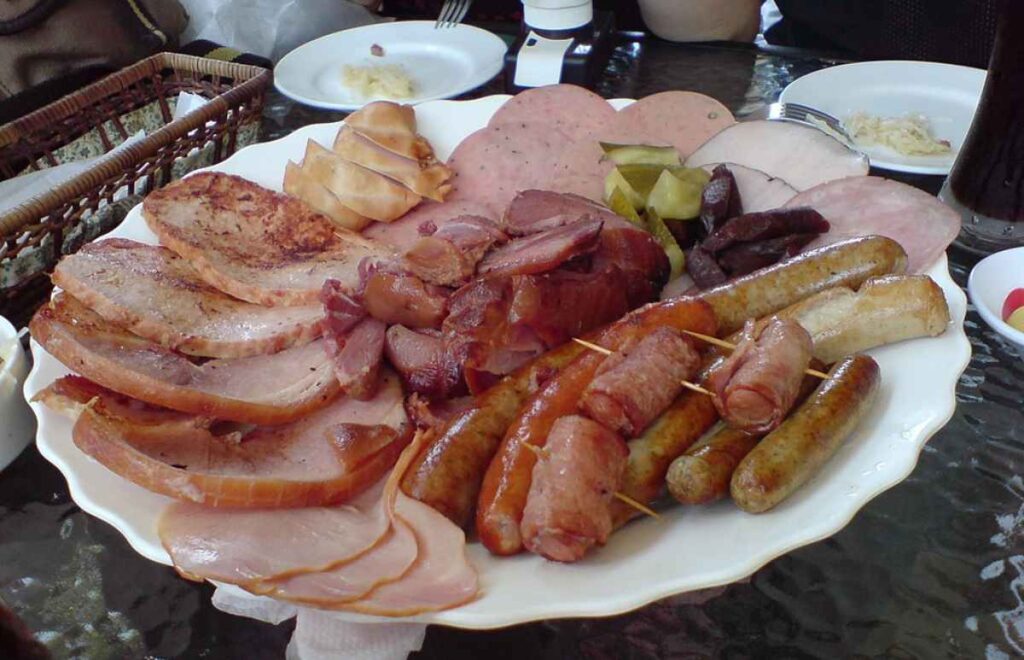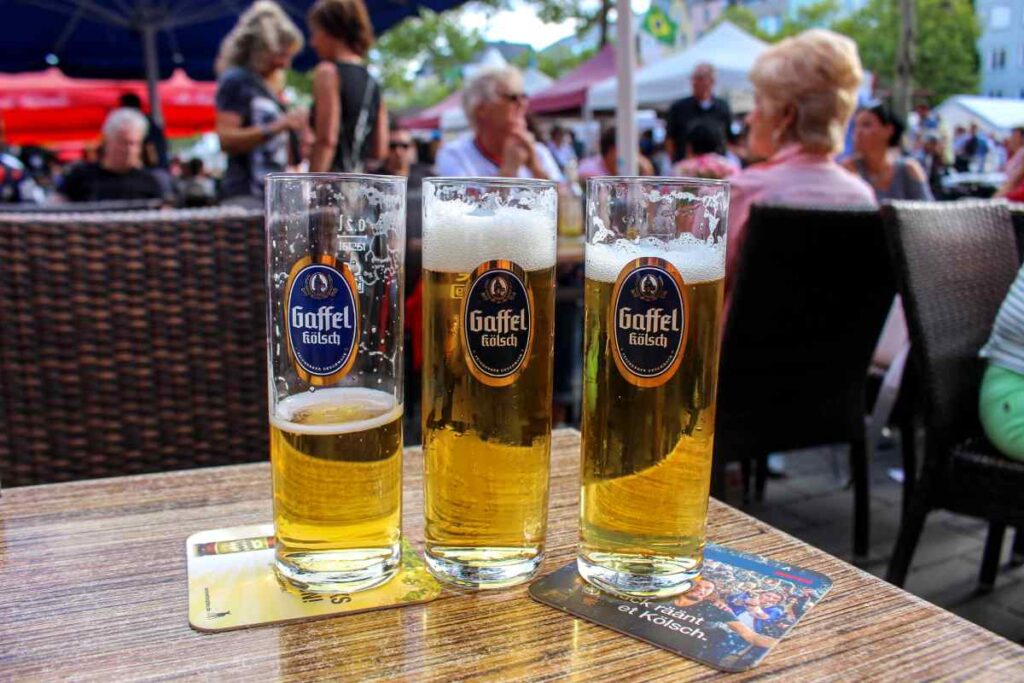What is a Kolsch? In this article, you will learn interesting facts about Kolsch.
Kölsch beer is a unique and refreshing beverage that possesses a rich history and tradition. Originating from the city of Cologne (Köln) in Germany, this popular ale is known for its crisp drinkability and exceptional balance of malt and noble hops. Kölsch combines attributes of both lager and ale beers, offering beer drinkers a delightful hybrid experience with a distinctive taste and appearance.
Brewed according to strict guidelines, Kölsch is a pale, highly attenuated, hoppy, and bright top-fermenting beer, adhering to the Reinheitsgebot, the German Beer Purity Law. Utilizing light pilsner malt, noble hops, and an ale yeast, Kölsch is fermented at warmer temperatures to impart a fruity aspect, followed by a few weeks at colder temperatures, a method often used in lagers. This distinctive brewing process results in a beer that captures the imagination of aficionados and casual drinkers alike.
With its crisp, delicate, and drinkable nature, Kölsch has become a popular choice for those who appreciate both its flavor and fascinating history. Its unique brewing process and adherence to traditional German beer standards truly set the Kölsch apart, making it a preferred choice for those seeking a memorable and authentic beer experience.
Table of Contents
History of Kolsch

Kölsch is a unique beer style originating from Cologne, Germany. This top-fermented beer uses ale yeast, noble hops, and light pilsner malt. The brewing process includes fermenting at warm temperatures, which imparts a fruity aspect, and then conditioning the beer at colder temperatures like a lager The Spruce Eats.
Interestingly, the term “Kölsch” itself, which also refers to the dialect spoken in Cologne, didn’t appear until 1918. Initially, it was lighter than the beers people were used to in Germany, and it struggled to gain popularity. It wasn’t until the 1960s that Kölsch production began to pick up steam, with 50 million liters being produced in 1960 Culture Trip.
Cologne has a rich history of beer brewing, with its contributions to Germany’s beer history stretching back at least a thousand years Kegerator.com. The city’s location along the Rhine River in Western Germany played a significant role in developing its brewery culture.
World War II had a considerable impact on Cologne, with devastating bombings that damaged much of the city. However, the local beer industry lived on, and Kölsch continued to be an essential part of Cologne’s cultural identity.
Today, Kölsch is considered the official beer of Cologne, and its production follows strict guidelines under the Kölsch Konvention. This agreement stipulates that only breweries within the Cologne region can officially call their beer “Kölsch” Wikipedia. This makes it a truly unique and regional beer style, which adds to its appeal for beer enthusiasts around the world.
Kolsch and the Beer Family
Kölsch is a unique style of beer originating from Cologne, Germany. Often described as a top-fermenting lager, Kölsch is brewed using an ale yeast. It is a pale, highly attenuated, and hoppy beer, adhering to the strict guidelines of the Reinheitsgebot (German Beer Purity Law).
This style of beer is characterized by its crisp drinkability and a well-balanced flavor profile, featuring delicate malt and fruity notes source. It belongs to the family of top-fermented beers, alongside other ales. Yet, Kölsch sets itself apart through its unique brewing process, which includes a cold fermentation and storage period (lagering) typically seen in lager-style beers.
Despite being an ale, Kölsch shares some similarities with pilsners, especially in terms of color and the use of noble hops and light pilsner malt. The combination of ale yeast and lagering techniques is what gives Kölsch its distinctive characteristics and makes it a so-called hybrid beer.
Traditionally, Kölsch is served in small, 200ml glasses called Stangen, to ensure that it is consumed fresh and cold. This is because the beer is best enjoyed straight from the keg and has a relatively short shelf life of three months.
In conclusion, Kölsch is a remarkable beer that combines the best of two worlds, merging the fruity and complex flavors of ales with the crisp and refreshing qualities of lagers and pilsners. Its unique brewing process and strict adherence to the Reinheitsgebot make it a fascinating addition to the beer family.
Kolsch Brewing Process
Ingredients
Kölsch is a German ale that originates from Cologne (Köln) and is known for its clean, crisp taste. The primary ingredients for brewing this beer include malt, noble hops, water, and a specific top-fermenting ale yeast. The malt used in Kölsch is predominantly Pilsner or pale malt, which lends the beer its clear, light color. The hops used are typically German noble hops that offer a delicate balance of bitterness and aroma without overpowering the beer.
Fermentation
Kölsch is unique in its brewing process, which combines elements of both ale and lagers. It undergoes a warm fermentation using ale yeast at higher temperatures than lagers. This top-fermented beer allows the yeast to impart fruity esters and a characteristically clean profile. The fermentation temperature usually ranges between 15-20°C (59-68°F) for a period of one to two weeks.
Cold Temperatures
After the initial fermentation, Kölsch is conditioned at cold temperatures like a lager, typically between 0-4°C (32-39°F) for several weeks. This process, known as cold conditioning, helps the beer develop a clear, bright appearance and enhances its refreshing crispness. It also allows the flavors to mellow, creating a well-rounded and balanced character.
During the final stages of production, Kölsch may undergo filtration to further improve clarity, although some brewers opt to leave their Kölsch unfiltered to preserve more of the original flavors. The final product has a moderate ABV (usually around 4.2-5.2%), low to moderate bitterness (20-30 IBU), and a distinctively dry, fruity finish. Kölsch is traditionally served in a tall, narrow glass called a Stange, which showcases the beer’s golden color and aids in maintaining its delicate carbonation.
Unique Characteristics of Kolsch
Kölsch is a distinctive beer style originating from Cologne, Germany. The beer is a pale, top-fermented ale with a crisp and fruity flavor profile. Brewed using ale yeast, noble hops, and light pilsner malt, Kölsch undergoes a unique fermentation process. Initially fermented at warm temperatures to impart a fruity aspect, it then spends a few weeks at colder temperatures, similar to lagering methods used in lagers1.
The style is known for its refreshing, easy-drinking quality, exhibiting a perfect balance between malt and fruit flavors. Some popular examples, such as Reissdorf Kölsch, showcase the style’s signature hoppy aroma and dry finish. The body of the beer is usually light, making it an excellent choice for warm weather and various occasions.
Kölsch holds a Protected Geographical Indication status in Germany, which means that only breweries located in the Cologne region can legally produce and label their beers as Kölsch2. This strict definition ensures the preservation of the traditional methods and ingredients used in Kölsch brewing. Consequently, the beer has become a symbol of local pride and craftsmanship.
In summary, Kölsch is a unique and refreshing beer style from Cologne, Germany. Its characteristics include a fruity and hoppy flavor, a crisp and light body, and a dry finish. The Kölsch production process involves both ale and lager brewing methods, and the style bears a Protected Geographical Indication status to maintain authenticity and quality.
The Kölsch Konvention
The Kölsch Konvention is a set of rules established in 1986 to protect the identity and quality of the Kölsch beer style. Only beers brewed in Cologne (Köln) that adhere to these specific standards can be officially labeled as Kölsch. The idea behind this regulation was to prevent breweries outside of Cologne from producing beer and labeling it as Kölsch, ensuring the uniqueness and quality of this beer style.
The strict set of standards agreed upon by the Kölsch Konvention includes a few key characteristics that define the beer. Kölsch must be pale in color, filtered, top-fermented, brewed between 11 and 14 degrees Plato, hop accentuated, and served in a stange glass. Furthermore, Kölsch has to be brewed according to the Reinheitsgebot, a German beer purity law that dictates only water, barley, and hops can be used as ingredients in brewing.
The Konvention has played a significant role in preserving the heritage of Kölsch beer and ensuring that its distinctive style and flavors remain true to their Cologne roots. Today, there are 23 different Kölsch brands produced in the region, all committed to maintaining the high standards set by the Kölsch Konvention.
By adhering to these strict guidelines, Cologne has managed to protect the integrity and reputation of its iconic Kölsch beer, remaining a key part of the city’s culture and identity.
Glassware and Serving

Kölsch is a unique beer style that demands specific glassware for the best drinking experience. In this case, a Stange glass is used to serve this refreshing, delicate brew. The Stange is a tall, slender cylindrical glass that can hold up to 6.8 fluid ounces, which enhances the beer’s appearance and aroma. Its slim design allows for excellent head retention and effectively showcases the beer’s brilliant clarity. This glass is commonly used in bars and pubs, rather than at home.
In many German bars, Kölsch is often served in a Kranz – a circular tray that holds multiple Stange glasses, making it easy to serve multiple glasses at once. This is especially practical in Cologne, where Kölsch originates, and where the local tradition involves continuous rounds of service. As soon as one glass is empty, a new one is brought until the customer explicitly requests for the service to be stopped.
The serving temperature of Kölsch is an important aspect of its enjoyment. It should be served at a slightly lower temperature than typical ales, ideally between 40-45°F (4-7°C). This cooler temperature further accentuates the beer’s crisp and clean flavor profile, while still allowing the subtle fruity and spicy notes to shine.
When pouring Kölsch into a Stange glass, angle the glass slightly and pour gently to create a steady stream of beer. Fill the glass about 3/4 full, then straighten it and continue to pour, allowing a one-inch head to form at the top. This will ensure proper foam and carbonation to enhance the overall drinking experience.
In conclusion, the proper glassware and serving of Kölsch play a significant role in the overall enjoyment of this distinct beer style. Utilizing a Stange glass and maintaining an optimal serving temperature will provide drinkers with the best possible experience of Kölsch, allowing its delicate nuances to shine.
Kolsch in the US
Kolsch beer, a uniquely German style, has gained popularity in the US as American craft breweries have started to experiment with this top-fermented beer. One of the key features of a Kolsch beer is its smooth and delicate profile, which often appeals to those who enjoy lighter lagers or ales.
As opposed to traditional German Kolsch beers, which often use noble hops like Tettnang, some American craft breweries have opted for incorporating American hops in their Kolsch recipes. This fusion of old and new world ingredients makes for a unique take on the classic style. Although Kolsch is not as widely recognized in the US as IPA or other craft beer styles, the BJCP includes it as a distinct style within its style guidelines.
Several notable American craft breweries produce their own versions of Kolsch. For instance, Mother Earth Brewing offers their Endless River Kolsch, which is well-regarded for its smooth, crisp finish and traditional German influence. Rogue Ales, another well-known brewery, presents their Honey Kolsch, made with wildflower honey, adding a touch of sweetness to the beer’s light and crisp profile.
Even larger breweries such as Ballast Point have experimented with Kolsch beer by producing their Pale Ale Kolsch, which aims to create a balance between American hop-forward pale ales and the traditional German Kolsch style.
In conclusion, the growing interest in Kolsch beer within the US showcases the versatility and adaptability of craft breweries in embracing and experimenting with this centuries-old German style. As more breweries explore Kolsch beer, American drinkers can expect to see further innovations and adaptations in the market.
Food Pairings

Kolsch beer is a versatile beverage that pairs well with a variety of dishes, allowing you to experience its unique flavors and subtleties. To help guide you through the world of Kolsch food pairings, we have listed some recommendations below.
It’s no surprise that traditional German dishes are a great match for Kolsch. The beer’s crisp and clean profile complements the rich flavors of German sausages very well. Both bratwurst and currywurst are excellent choices, as the mild bitterness and subtle fruitiness of the beer balance the spiciness and richness of the sausages.
When it comes to fruit, Kolsch pairs nicely with cherry and apple flavors. A German cherry pie or a beautiful tarte tatin can be an excellent dessert pairing, as the sweetness of the fruit is balanced by the beer’s slight bitterness and refreshing finish.
For those who prefer savory dishes, Kolsch can also pair well with lighter fare, such as salads, seafood, and other grilled meats. Its clean, crisp, and refreshing palate makes it a great choice to balance the flavors in these dishes, which are often dominated by lemon, herbs, or spices. A nice, bright mustard-based potato salad or grilled shrimp can bring out the best in a cold Kolsch.
In summary, Kolsch beer offers a wide range of food pairings that highlight its delicate flavors while enhancing the overall dining experience. From traditional German sausages to fruit desserts or lighter, savory dishes, there is no shortage of options for you to explore and enjoy with this versatile beverage.



